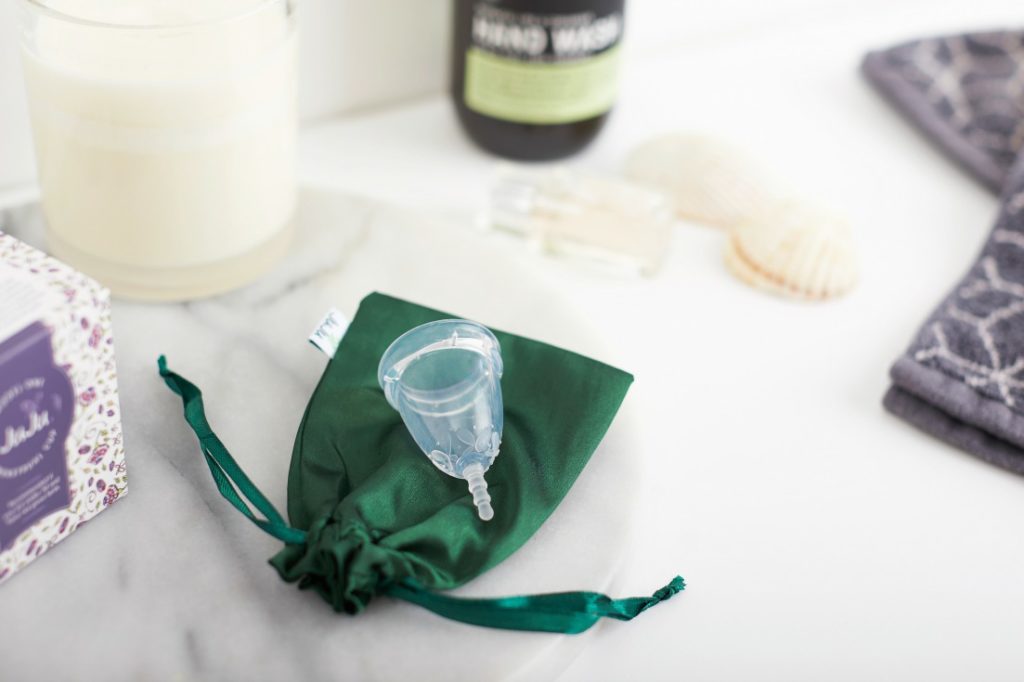
Today we’re going to talk menstruation! Pictured here: a JuJu Cup (Photo by JuJu Cup)
Today’s post is about, you guessed it… menstruation! Even just a few years ago, I had no idea that there were any menstrual products beyond commercial-brand pads and tampons. Menstrual cups? Reusable pads? Free bleeding!? In this post, I’m going to lay out all the the options that we have to menstruate sustainably, to bleed in a way that is good for our bodies and good for the Earth.
This is a post for folks of all genders, because folks of all genders menstruate. As such, I will refrain from using the term “woman”, and instead refer to folks who menstruate as “menstruators”. This post is for non-menstruators as well (cis men, I’m looking at you! When was the last time you sat down and educated yourself about menstruation?). Also, while this post provides additional tips for travelers, this information is relevant for non-traveling menstruators as well.
Additionally, I want to point out that this post discusses menstrual products, not “feminine hygiene products” or “sanitary pads”, etc. Menstruation is not unhygienic! The very language used to describe menstrual products implies that menstruation is dirty and unsanitary (and inherently female, ignoring the fact that not all women menstruate and that some men and gender-nonconforming folks do menstruate). As such, in this post I call these products what they are: menstrual products. Not feminine. Not “sanitary”. Just menstrual products.
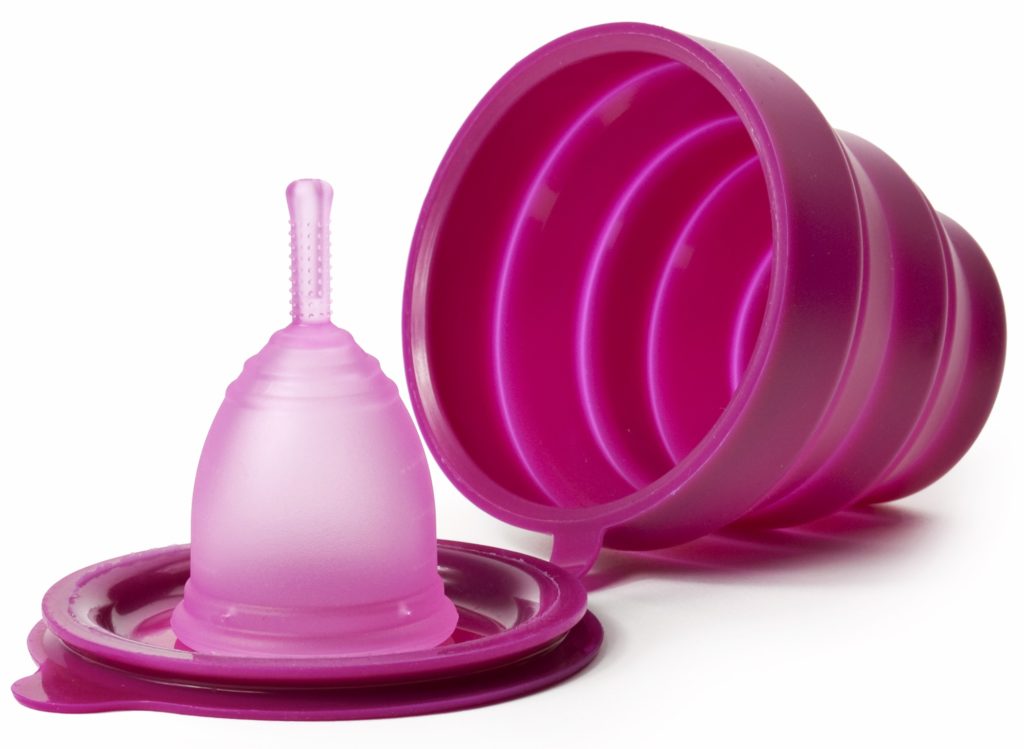
One of many options for sustainable menstruation! This one: a Ruby Cup (Photo provided by Ruby Cup)
Now… you may be wondering why there is a need for sustainable menstrual products. After all, most menstruators have been using standard pads and tampons for years. However, choosing a sustainable menstrual product over a conventional product is actually an act of resistance.
Conventional pads and tampons are pretty nasty. They’re full of chemicals that go on or inside of the most porous part of your body. Conventional menstrual product companies are manipulative, profit-driven, and disregard the health of folks who menstruate. Did you know that it wasn’t until a number of menstruators died after using a super-absorbent tampon that the FDA began regulating tampon absorbency? Also, the FDA has not required that menstrual product companies disclose the chemicals that are used in pads and tampons, so who knows what crap we’re putting into our bodies?
And speaking of manipulative, guess who taught us to be ashamed of menstruation in the first place? Throughout the 20th century, the majority of the menstruation information published (videos, pamphlets, etc.) and marketed to adolescents was actually created by the menstrual product companies themselves. And the majority of this “educational material” consisted of misogynist conceptions of menstruation as dirty, gross, smelly, unhygienic, and something that should be kept secret. Menstrual product companies literally capitalized on the negative conceptions of menstruation, and taught young menstruators both to be ashamed of menstruation, and that by simply purchasing their products, menstruation would remain a secret.
Needless to say, I am not a fan. I switched over to sustainable menstrual products years ago, and I have never regretted the decision. Not only do I save so much money per month, but I’m no longer putting money in the pockets of the menstrual products companies who are profiting off of misogyny and oppression. Physically, I feel healthier since I switched over to sustainable menstrual products. Plus, I feel like I’m doing my part for the Earth! By not using pads and tampons, I’m avoiding a remarkable amount of landfill waste.
So here I present you with a plethora of sustainable menstrual products. Happy bleeding!
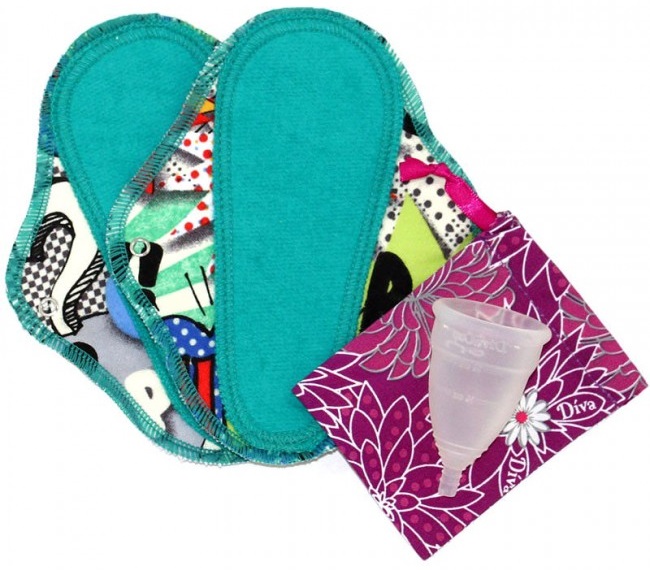
Reusable pads and a menstrual cup! (Photo by Lunapads)
*This post may contain affiliate links. If you make a purchase through one of these links, I will earn a commission at no extra cost to you!*
Organic pads and tampons
I would say that organic pads and tampons are the simplest transition to sustainable menstrual products from conventional products. They are regular pads and tampons, but are made from organic cotton. Organic pads and tampons do not contain the same chemicals and bleaches as conventional products, such as dioxin (which is a carcinogen!).
Pros for organic pads and tampons include:
- No learning curve, as is the case with some other sustainable menstrual products.
- No chemicals being placed against/inserted into the most porous part of the body.
- Generally made without fragrances and other irritants.
- Organic pads and tampons are biodegradable and compostable.
Cons for organic pads and tampons include:
- The price tag. Unfortunately, you generally pay more for organic products than conventional products.
- The ease of purchase. You aren’t going to be able to find these products in all drugstores or grocery stores, since they are a specialty item. They are generally readily available in natural food stores, however. Also, you can readily find them on Amazon!
- For traveling menstruators, using organic pads and tampons means that you will probably have to stock up before your trip, to have pads and tampons to last throughout your travels.
Some brands to check out are: Natracare, The Honest Company, NatraTouch.
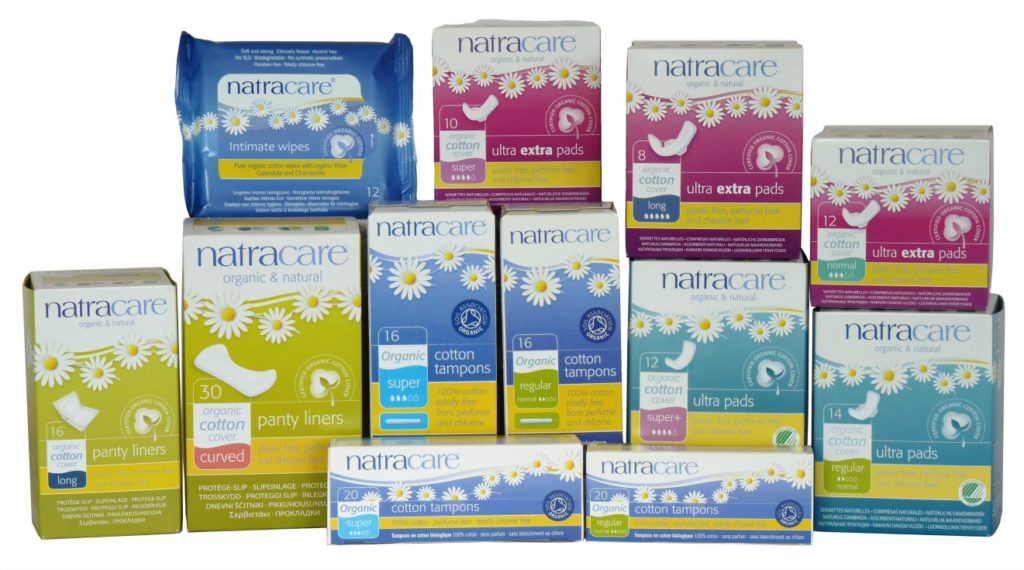
So many pads and tampons! These are by Natracare (Photo by Natracare)
Menstrual Cups
Ah, menstrual cups. If you’ve been following this blog for a while then you probably know that I’m a big fan! I had a sliiiight issue trying to get one through customs in Dubai – you can read all about it here.
So what is a menstrual cup? It’s a little cup, made of medical-grade silicone, that you fold up and insert into your vagina during your period. The cup pops open and sits against your cervix, catching the blood. If it’s properly placed, you shouldn’t even notice that it’s there until it’s time to take it out. Because it makes a seal around your cervix, it shouldn’t leak (generally leaks only happen if the cup has been improperly inserted).
Menstrual cups are a great long-term, low cost option for sustainable menstruation. Most cups cost between $25 and $40, and last for years. Many cups come in at least two sizes: a smaller size for those who have never given birth vaginally, and a larger size for those who have. Additionally, some menstrual cups come in longer or shorter sizes, which is beneficial for menstruators with higher or lower cervixes. I use a Diva Cup, which is readily available throughout the United States, though there are many different menstrual cup brands that you can experiment with to find the one that fits best.
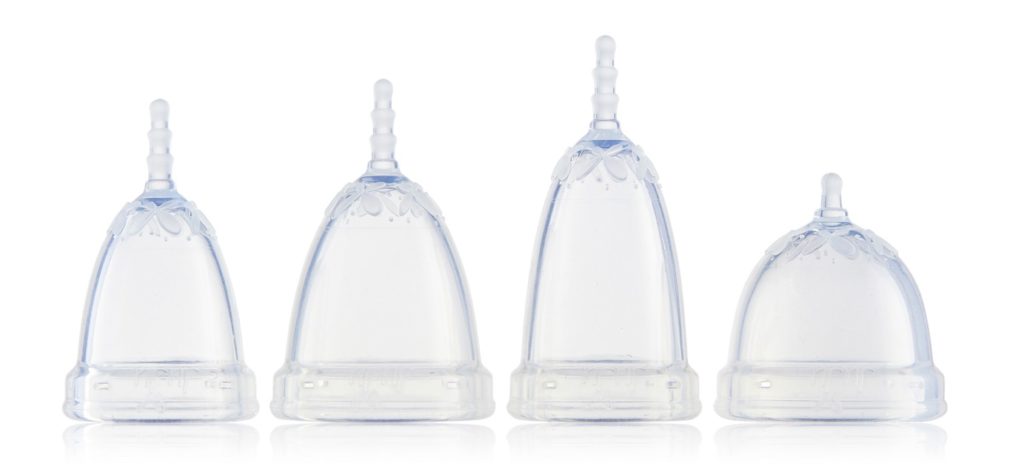
The JuJu Cup comes in four sizes! From left to right, the sizes are: pre-vaginal birth, post-vaginal birth, a high-cervix cup, and a low-cervix cup (Photo by JuJu Cup)
Pros for menstrual cups include:
- A one-time, upfront cost of approximately $30 (making it a great long-term option, financially).
- No waste beyond the initial packaging waste, great for sustainably conscious menstruators.
- Most cups are made from medical-grade silicone, so they contain no nasty chemicals (important, because the cup gets inserted in the most porous part of the body!).
- Menstrual cups are small and easy to carry around, so they are a convenient option for travelers (no more packing months-long stashes of tampons for long-term travel!).
Cons for menstrual cups include:
- There is a learning curve to menstrual cups! They are bigger than tampons and require learning how to fold it, insert it, adjust it, sometimes readjust it… it took me a few cycles and many Youtube videos to learn how to use my menstrual cup properly. Be patient, it’s worth it!
- Using a menstrual cup means that you need to get comfortable touching your body. I’m going to count this as a secret pro… but let’s be real, you’ve got to be okay with touching yourself and your menstrual blood (because yes, it will get on your hands).
- Unlike pads and tampons, which can be surreptitiously disposed of in waste bins inside bathroom stalls, you might have to occasionally wash your menstrual cup in a shared restroom where – gasp! – people might see it. I think that this is actually a pro as well, because we need to get over the idea that we should be embarrassed about menstruation, but for shy folks who are self-conscious about displaying a menstrual cup and menstrual blood in public, this is another adjustment when switching over to a menstrual cup.
- Menstrual cups should be cleaned in potable water, so travelers in water-contaminated areas should take extra care in cleaning the cups.
I recommend the Diva Cup, which comes in two sizes: Size 1 (pre-childbirth) and Size 2 (post-childbirth).
Some other menstrual cup brands to check out are: Mooncup (a UK brand – see MCUK for the product sold in the US), Ruby Cup, Lily Cup, Lunette Cup (a Finnish brand), JuJu Cup (an Australian brand), Keeper Cup.
Reusable pads
Reusable pads are another great, sustainable option for menstruators. These pads are typically made from cotton, or sustainable fabric such as bamboo. They snap around your underwear (similar to a conventional pad with wings). Cloth pads come in different sizes, for heavier or lighter days. They are also available for thong underwear. You can find plain reusable pads, as well as pads made from all sorts of cool fabrics.
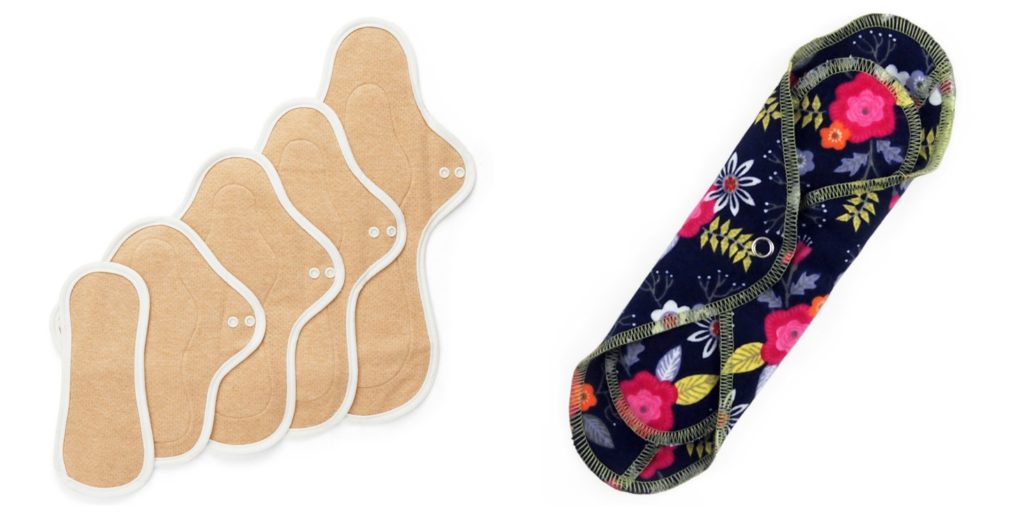
Left: Reusable pads in multiple sizes (Photo by JuJu Cup); Right: A colorful reusable pad (Photo by Gladrags)
Reusable pads can be thrown in the laundry after use (and can go in with your clothes). Depending on the fabric, they can be machine dried or air dried. Reusable pads have a lifespan of many years, making them a great long-term, low-cost option for menstruators. Like with menstrual cups, there is an upfront cost (usually between $10 and $30 for a pack containing 3-10 pads), but after this initial investment, you’re set!
Pros for reusable pads include:
- A one-time, upfront cost of approximately $30 (making it a great long-term option, financially).
- No waste beyond the initial packaging waste, great for sustainably conscious menstruators.
- No learning curve. You just pop it in, snap the snaps, and bleed! When it’s time to take it out, you can rinse the pad and then toss it in the washing machine.
- Reusable pads are external products, so they’re perfect for folks who don’t want to insert anything inside their bodies.
- The cuteness factor (if that’s your thing!). I like that reusable pads come in all sorts of cool fabrics.
- For craftier folks, these products are also something you could DIY!
Cons for reusable pads include:
- Since reusable pads snap in as opposed to sticking onto the underwear via adhesive, some brands do shift about due to movement (wearing cotton underwear as opposed to spandex should help to minimize slipping, though).
- Because the pads are external items and involve extra fabric being inserted into your underwear, in hot weather they may not be quite as comfortable. (Same goes for conventional pads, though!)
- Reusable pads are not easily found in stores, but are readily available online, such as on Amazon and Etsy.
- For travelers without regular access to laundry facilities, washing the pads may be more of a challenge. In this case I would recommend hand-washing the pads in the sink and then letting them air dry. Single-use packs of laundry detergent are your friends!
Some brands to check out include: Gladrags, Lunapads, Heart Felt, Wegreeco.
Period underwear
Period underwear looks like regular underwear, but is designed with extra material in the crouch to absorb menstrual blood. Some period underwear is designed to be an alternative to other menstrual products, and some is designed for use with other menstrual products (to be worn as extra protection from leaks).
Period underwear is machine washable, though depending on the fabric, the underwear may need to be air dried. Period underwear also has a lifespan of many years, so after the initial investment (usually around $10-$40 for a single pair or a pack with multiple pairs), the continual use of period underwear should cut down your menstruation expenses, especially if used alone or coupled with other sustainable menstrual products.

A few different styles of period underwear, depending on your underwear preferences (Photo by Lunapads)
Pros for period underwear include:
- Period underwear is meant to be very comfortable, and not chafe against the body.
- Period underwear is an external product, so it’s perfect for folks who don’t want to insert anything inside their bodies.
- Period underwear can provide an extra barrier to avoid staining your clothes. To be clear, there is absolutely nothing wrong with leaking through our clothes, and a large part of breaking down menstrual shame is getting over the idea that leaks are embarrassing. That being said, it’s also not very fun to scrub blood out of your favorite pair of jeans, so having some extra leak protection can be positive as well.
- Period underwear is discreet, making it a good option for travelers who want to menstruate sustainably but are worried about other folks seeing their menstrual products. Period underwear looks just like regular underwear, so no worries there!
Cons for period underwear include:
- Period underwear generally works best when worn with other menstrual products, such as pads, tampons, or menstrual cups. Not ideal for someone looking to minimize their menstrual routine.
- For travelers without regular access to laundry facilities, washing the underwear may be a challenge. Once again, hand washing and air drying is your friend.
Some brands of period underwear to check out include: LunaUndies, Yoyi Fashion, Anigan.
Also, I want to highlight a company called Pyramid Seven, a queer-owned company from Chicago, that specifically makes period boxer briefs for menstruating folks, regardless of gender. Their boxer briefs contain some additional fabric to allow for pads with wings or snaps. Great for those who want period underwear, without the frills of bikini cuts and lacy bits.
Other
Here I want to mention briefly a few other options for sustainable menstruation, such as menstrual sponges and free bleeding.
Menstrual sponges are natural sponges that, yes, come from the sea. They come in multiple sizes, and are inserted into the vagina during menstruation, where they absorb the blood. I have never tried menstrual sponges, and have read mixed reviews. Some love it as an alternative to tampons and menstrual cups; some are not a fan. Also, for the sake of full disclosure, the FDA has labeled them as “risky devices”. Because they come from the sea, menstrual sponges have been found to contain sand, bacteria, and other particulates. However, some doctors recommend them and proclaim that menstrual sponges are perfectly safe. If you decide to use one, I would consult your doctor or health care provider, and make sure to clean it thoroughly before use.
Finally, I’d like to finish up this post with a discussion of free bleeding!
https://www.instagram.com/p/0ovWwJHA6f/?taken-by=rupikaur_&hl=en
Free bleeding is just what it sounds like: unrestricted bleeding, without using any sort of menstrual product. It’s not exactly a new concept, as many folks free bled for years before pads and tampons came around (and many folks free bleed today: some intentionally, and some due to a lack of access to menstrual products). Free bleeding is revolutionary in that it rejects the notion that menstruation must be contained or hidden. See Rupi Kaur’s amazing photo and text above. Also, see this interview with Kiran Gandhi, the runner who famously free bled during the 2015 London Marathon. Free bleeding might not be appealing to the majority of folks, though I think that the concept behind it is what is most important: namely, that we all become more comfortable with menstruation, with our blood, and with leaks, and that we need not be forced into boxes of “appropriate” ways to menstruate.
I hope you found this post helpful! If you liked this post, be sure to check out the next installment in my menstruation and travel series, in which I interview my good friend Emilie Pichot, an artist, activist, and world traveler, about all things travel and menstruation.
There you have it! A roundup of sustainable menstrual products for travelers and everyone! Have you tried any of these products? What has worked for you or what hasn’t? Any recommendations for traveling menstruators? Let me know in the comments below!
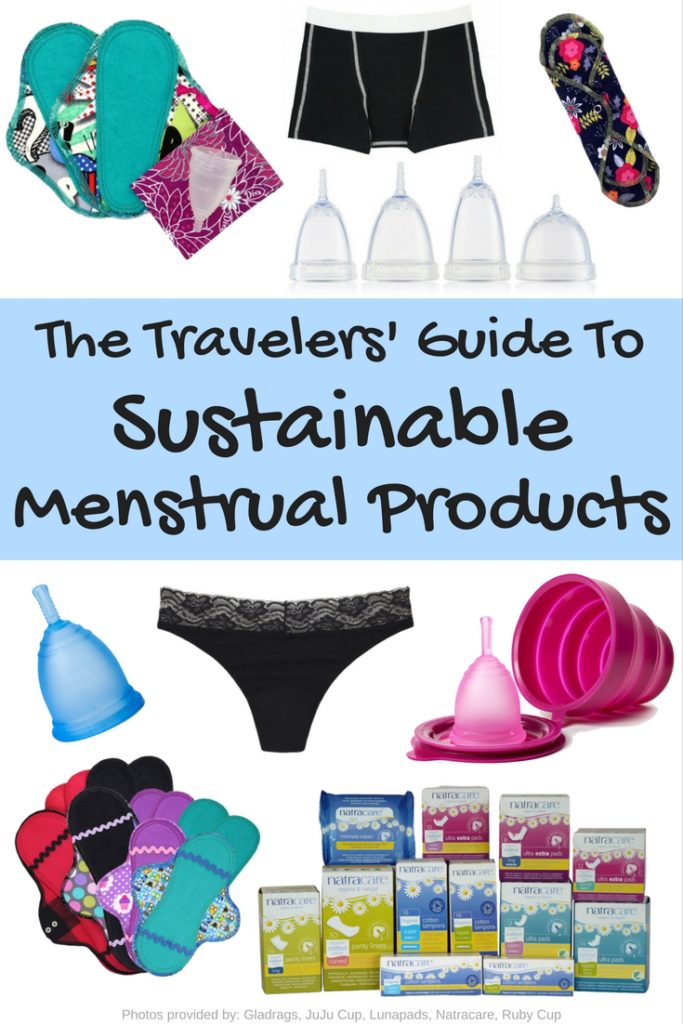









2 comments
Cups are definitely a learning curve. I’ve been using mine for two years now and literally JUST ended up with a stain. It’s some comfortable even when it’s not on quite right that pantiliners are still a must. Which is why I’m so happy to learn of reusable pads from your blog! Thanks!
I know what you mean – I’ve been using mine for a few years and I still occasionally get leaks. Still though, for me it’s a small price to pay for everything that I love about using a menstrual cup! I’m glad to hear that this article was helpful to you!! I hope the reusable pads work out 🙂 Thanks for reading and commenting!